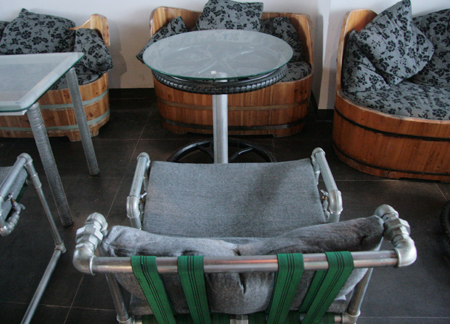Expo's first zero-carbon pavilion
Situated in the Urban Best Practices Area of the Shanghai World Expo, the London ZedPavilion showcases some of the world's most advanced low-carbon technologies and solutions for sustainable urban development, as well as demonstrating what a zero-carbon lifestyle is like.
|
|
|
London ZedPavilion at Shanghai World Expo [Yuan Fang/China.org.cn] |
The first zero-carbon pavilion in China and in expo history, the ZedPavilion was inspired by the Beddington Zero Energy Development (BedZed), the first zero-carbon emission community in the world, which was built in 2002 in south London. Half the development is owner-occupied, 25 percent consists of shared ownership units reserved for firefighters, nurses and other key workers, and 25 percent is social housing for rent.
To achieve zero emissions, the ZedPavilion uses wind cowls, wind turbines, solar panels, and bio-gas generators to reduce energy consumption and ensure remaining energy demand is met by zero-carbon sources, said Chen Shuo, director of the pavilion told China.org.cn in an exclusive interview.
|
|
|
Chen Shuo, director of London ZedPavilion [Yuan Fang/China.org.cn] |
Covering an area of 2,500 square meters, ZedPavilion is composed of two connected carbon-neutral buildings.
Inside the four-story buildings, visitors can experience a real zero-carbon life by touring the pavilion's zero-carbon auditorium, restaurant, exhibition hall, and six different zero-carbon show houses, where all the furniture and decoration are carbon-neutral.
|
|
|
Chairs and tables made of used tires, steel pipes and wooden barrels [Yuan Fang/China.org.cn] |
In the zero-carbon restaurant, even the chopsticks and dishes can be eaten along with the food as they are made of chocolate and pastry.
 |
|
Chopsticks and dishes made of chocolate and pastry inside the ZedPavilion [Yuan Fang/China.org.cn] |
"The message we are trying to convey in this case is that through low-carbon development and low-carbon technology, we can make city a better place to live in and a better place to stay," said Chen. "Because in our daily life, city is the source of noise, energy consumption, traffic jams, pollution. We are trying to constitute a future city which can solve all these problems, which makes city a much better life."
Since its opening on May 1, the ZedPavilion has received half a million visitors, many of them government officials and industry players.
"We have been meeting so many government officials since the expo opened (on May 1) and the majority of them have very positive reaction in what we do in the pavilion and also believe this is the future where China is going to be," said Chen. "They came to bring the zero-carbon pavilion back to their cities."
Chen said that they are initiating a new scheme to build one zero-carbon pavilion in each Chinese city.
"The pavilion will be the milestone or anchor point of when the city is going to zero-carbon, because once the pavilion is built in a city, it will start generating electricity, generating water processing capability and generating waste disposal capabilities. That would set a new model of community and how people make money. Once it makes money for people, it will become popular."
When the Expo ends at the end of October the ZedPavilion will be retained as a permanent Zero Carbon Museum.
Fast Facts about the London ZedPavilion:
Location: Zone E of the Expo Park
Total Area: Approximately 2,500 square meters
Key Feature: Zero-carbon community
 0
0 









